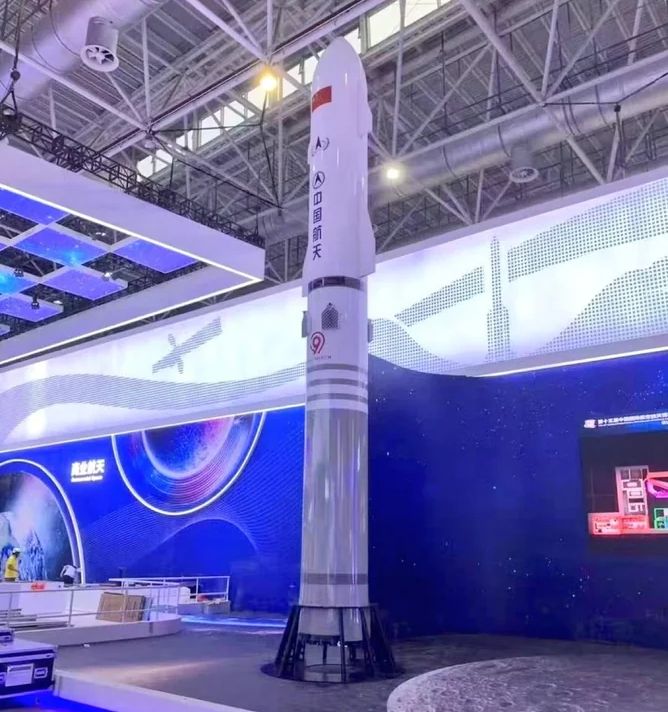

# China’s Long March 9 Rocket: A New Chapter in Reusable Spaceflight
In the swiftly changing realm of space exploration, China has once again captured attention with its innovative strides in rocket technology. The Long March 9, originally designed as a traditional super heavy-lift rocket, has experienced considerable design modifications over the last ten years. Most notably, it now incorporates a reusable first stage and an upper stage fitted with flaps, showcasing striking similarities to SpaceX’s Starship. This evolution signifies a critical turning point in China’s space ambitions, as the nation aims to contend with the United States in the pursuit of lunar leadership and further.
## A Decade of Transformation
When Chinese space officials first presented the Long March 9 design nearly a decade ago, it was intended as a completely expendable rocket. The initial plan included three stages along with solid rocket boosters affixed to its sides, resembling conventional heavy-lift rockets such as NASA’s Space Launch System (SLS). However, the swift advancements made by SpaceX, particularly in reusable rocket technology, prompted China to reassess its strategy.
Two years prior, China revealed that it had revised the Long March 9 design to integrate a reusable first stage. This represented a major advancement, aligning the rocket more closely with the reusable models pioneered by SpaceX. However, the most recent updates, presented at the Zhuhai Airshow in China, demonstrate that the Long March 9 has experienced yet another evolution — and this time, it closely resembles SpaceX’s Starship.
## A Recognizable Design
The revamped Long March 9 will boast a fully reusable first stage powered by 30 YF-215 engines. These engines utilize methane and liquid oxygen as propellants, paralleling SpaceX’s Raptor engines. Each YF-215 engine produces around 200 tons of thrust, in comparison to the 280 tons generated by Starship’s Raptor engines. Although the thrust outputs differ slightly, the overall configuration of the Long March 9’s first stage is strikingly akin to that of Starship.
In addition to the reusable first stage, the Long March 9 will also feature a reusable upper stage. This stage is outfitted with flaps in a design that closely mirrors Starship’s second stage, which employs similar aerodynamic structures for controlled descent and landing. According to Chinese officials, the inaugural flight of this new Long March 9 is slated for 2033, allowing China nearly ten years to enhance and perfect the design.

*Credit: [Weibo](https://weibo.com/5658451754/5097057303924135?layerid=5097057303924135)*
## The Impact of SpaceX
China’s choice to mirror SpaceX’s designs is not entirely unexpected. Over recent years, both state-run and private Chinese space firms have assimilated numerous practices pioneered by SpaceX. For example, Space Pioneer, a Chinese startup, has been developing a Falcon 9 replica, while another startup, Cosmoleap, has unveiled intentions to create a fully reusable rocket named “Leap.” Cosmoleap’s design even features a tower-based “chopstick” recovery mechanism, akin to the one SpaceX utilizes to capture its Starship boosters.
This inclination to replicate SpaceX’s advancements extends beyond private enterprises. China’s state-operated space agency has swiftly embraced reusable technologies in reaction to SpaceX’s achievements. The latest design of the Long March 9 exemplifies this, as China strives to narrow the gap with the United States in the quest for space supremacy.
## The Genuine Space Race
While China has rapidly adopted reusable technology, the larger context of this advancement is the ongoing space rivalry between China and the United States. Both countries are competing for supremacy in space, particularly in the endeavor to establish a foothold on the Moon. NASA and China’s space agency find themselves in a contest to explore the lunar South Pole, an area believed to harbor precious water ice reserves that could facilitate prolonged human settlement.
China’s initial lunar endeavors will be carried out using the Long March 10, a more traditional rocket. These missions, anticipated in the upcoming years, will consist of brief visits to the Moon. Nevertheless, China is relying on the Long March 9 to enable more ambitious lunar initiatives, including the creation of permanent lunar bases. The reusable design of the Long March 9 will be essential for ensuring the economic feasibility of these missions, as reusability significantly lowers the expenses associated with launching heavy payloads into space.
## A Contest for Reusability
The crux of winning the new space race lies not merely in reaching the Moon first, but in establishing the infrastructure for sustained presence there. In this aspect, the nation that excels in reusable super heavy-lift rockets will hold a substantial edge. SpaceX’s Starship is already airborne, affording the United States a